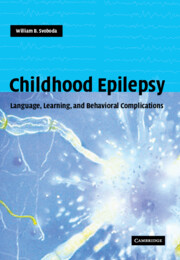Book contents
- Frontmatter
- Contents
- Preface
- Glossary
- 1 Looking ahead
- Part I Speech and language problems
- Part II Learning problems
- Part III Behavior problems
- 27 Mental health needs
- 28 Psychologic development
- 29 Seizure types and modifying factors
- 30 Overview: extrinsic factors
- 31 Behavior problems: general
- 32 Attention deficit disorders
- 33 Anxiety disorders
- 34 Mood disorders
- 35 Disruptive behavior problems
- 36 Psychoses of epilepsy
- 37 Non-epileptic events
- 38 Possible treatment issues
- 39 Helping with psychiatric problems
- 40 Epilog
- Index
- References
28 - Psychologic development
from Part III - Behavior problems
Published online by Cambridge University Press: 26 October 2009
- Frontmatter
- Contents
- Preface
- Glossary
- 1 Looking ahead
- Part I Speech and language problems
- Part II Learning problems
- Part III Behavior problems
- 27 Mental health needs
- 28 Psychologic development
- 29 Seizure types and modifying factors
- 30 Overview: extrinsic factors
- 31 Behavior problems: general
- 32 Attention deficit disorders
- 33 Anxiety disorders
- 34 Mood disorders
- 35 Disruptive behavior problems
- 36 Psychoses of epilepsy
- 37 Non-epileptic events
- 38 Possible treatment issues
- 39 Helping with psychiatric problems
- 40 Epilog
- Index
- References
Summary
There are two definitions of normal. The psychologist defines “normal” as the standard and calls everything else abnormal, i.e. imperfect. Doctors, parents, and teachers use the term “normal” to describe a child who seems likely to grow up to be a satisfactory member of society in spite of the fact that symptoms and signs of inconvenient behavior are clearly present (Winnicott, 1964). A normal child can employ any or all of the devices that nature has provided in defense against anxiety and intolerable conflict. An abnormal child shows a limitation and rigidity to employ symptoms and a positive lack of relationships between the symptoms and what can be expected in the ways of help (Winnicott, 1984).
Differences arise when there is a fundamental clash between the reality of the external world and the child's inner world of feelings. Differences also arise with the discovery that with excitement go destructive thoughts. The child must decide between the peace of mind of restraint versus the eagerness of satisfaction of desires. The child begins to create an inner world in which battles are lost and won, a world in which magic holds sway. The child's play may allow glimpses of this inner world (Winnicott, 1984).
Behavior lateralization and localization
There is no strict localization for various emotions and consequent behaviors. The frontotemporal limbic system is often spoken of as the primitive brain, subject to more emotions than cognition.
- Type
- Chapter
- Information
- Childhood EpilepsyLanguage, Learning and Behavioural Complications, pp. 415 - 424Publisher: Cambridge University PressPrint publication year: 2004



